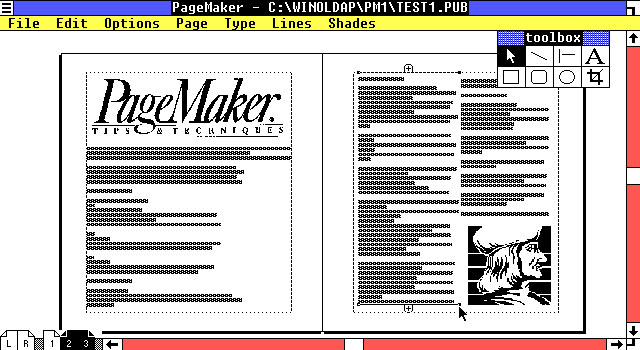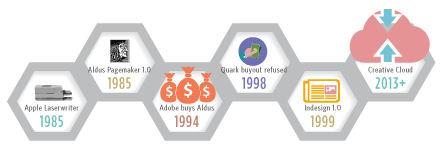What is Indesign Cc
Indesign and desktop publishing
Creating media content used to be a cumbersome process. It involved a lot of people and specialised tools, so the accessibility issues were a problem for most of the people who lacked the resources.
Everything has changed, due to software like Adobe InDesign. Its quarters lie in a small sector of your hard drive. The little people working there are lightning fast and never get tired, allowing you to bring to life any thought or image created by your brain.
We are going to start a small journey through the world of desktop publishing, at the end of which you’ll have a clearer image of how this field can change your life forever.
Desktop Publishing?
Desktop publishing software allows you to create layouts for different types of documents or media content. The great advantage is that the typographic quality is the same as traditional printing, thus allowing practically anyone to produce high quality and ready to print materials without the need to outsource.
Ok, but what does that mean for me, you might ask. First of all, this is a great gateway for wannabe artists who have some brilliant ideas and need an environment where their vision would become a reality. No longer do you have to linger outside the rich man’s door, nor have the excuse that you weren’t allowed to express yourself due to the lack of resources. All you need is a computer and a good piece of software, and that’s it. You can start immediately.
But this is just the beginning. Maybe you want to spread a social message. Maybe you want to create some comic books, or want to shine in your company with original marketing flyers or a corporate newsletter. You might need to help your parents sell something, as you see them struggling with newspaper ads that no one reads anymore. The possibilities and applications of this technology are limited only by your prejudice and preconceived ideas. So take a step forward and join the creative community. It’s easy to enter, and we have tea and cookies!
A Small History Lesson
Before we jump into the technical side, a small incursion back in time, to see how it all started.
Pagemaker is Indesign’s predecessor and was released in 1985 when Apple released the LaserWriter printer, which allowed users to print in the comfort of their homes. Pagemaker, created by Aldus, shortly turned into the standard for the newly born DTP industry. As a turning point in history, it allowed the typesetting industry as well as the personal computer industry to develop with the remarkable results now apparent.
Here Comes InDesign
As with all great stories, we find twists and turns when we start talking about InDesign. Its origins are strongly related to PageMaker, as Adobe purchased Aldus in 1994.
In the following years, PageMaker was bashed by the rival Quark with its QuarkXPress suite, which had a lot more features and popularity at the time. By 1998, Adobe was struggling to survive in the market and at some point Quark made an offer to acquire them and define their position as absolute rulers of the professional DTP market.
The good news is that Adobe refused the offer. They’d been working on a project codenamed K2, which was released in 1999 as InDesign 1.0. With some great marketing decisions, InDesign became in 2002 the first Mac OS-X native DTP software, gaining momentum and becoming more and more popular. When we got to the third version, it was included in Adobe’s Creative Suite, along with a few other killer apps such as Illustrator and Photoshop.
One of the reasons InDesign became the number one option for the professional segment was the wide range of options and innovations. Each release brought a bunch of new concepts, like the introduction of Unicode support, OpenType fonts that used advanced typography, the advanced transparency features, cross-platform scripting. Soon enough they left their competitors behind and built a strong user community that helped them refine their product even more.
Technicality
It would take me a whole book to write about all the features that InDesign has, so I’m going to stick to the most important ones.
First and foremost, Indesign uses a Frame Box Approach, meaning that every element that you work with can be easily rearranged and controlled. This feature gives you a lot of flexibility and allows you to do last minute editing without having to worry that everything will be turned upside down.
The workspace offers a ton of options and can easily be customised according to your needs. The WYSIWYG approach makes it very easy to create different styles that you know will look good once the printing process starts.
Indesign is a multi-purpose tool. Although it has all you need to create high-quality print content, you can easily export your work for digital devices as well. Be it online magazines, e-books or interactive PDFs, with some clicks you can get things done, which means you will spare dozens of hours of extra work.
You can insert video, audio or animations in your documents, creating interactive storybooks and engaging dynamic content for tablets or smartphones. It also supports XML, style sheets and other useful technologies, meaning that you can export your work for other online uses.
When it comes to professional use, InDesign doesn’t have many competitors, bringing us to the next foggy chapter.
Corporate Greed?
After reaching the top of the mountain, Adobe’s Administration Council had an idea. They decided to change their business strategy and switch to a service/subscription model. This huge change sparked a huge controversy back in 2011 when the Creative Cloud was first announced.
The problem with such an approach is that it strips the user of the minimal amount of rights over the product. As a subscription-based service, users pay a monthly or annual fee instead of owning a physical product that can be sold on to others or donated to charity.
Despite strong reactions from the user base and community, the company has held on to their plan, stopped releases for Creative Suite (and have for over two years) focussed on Creative Cloud products.
Conclusion
In the end, Adobe Indesign remains the most powerful desktop publishing software available to both professionals and beginners. We’ve delivered training in Indesign for the last ten years to help people along the path towards success, fame and discovering new skills and abilities. You can find out more about our Indesign courses here.
photo credit: 3D Cloud Computing (license)





